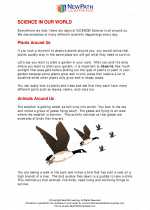Arthropods
Arthropods are a diverse group of invertebrate animals that are characterized by their jointed limbs and a hard exoskeleton. This group includes insects, spiders, crustaceans, and centipedes, among others. Arthropods are found in almost every habitat on Earth and play important roles in various ecosystems.
Characteristics of Arthropods
- Exoskeleton: Arthropods have a tough exoskeleton made of chitin, which provides support and protection for their bodies.
- Jointed Limbs: Their bodies are segmented, and they have jointed appendages that allow for a wide range of movement and specialized functions.
- Open Circulatory System: Arthropods have an open circulatory system, where blood is pumped into the body cavity and comes into direct contact with tissues and organs.
- Molting: Arthropods undergo molting, shedding their exoskeleton to accommodate growth.
Types of Arthropods
Arthropods are divided into several major groups, including:
- Insects: The largest group of arthropods, insects have three body segments (head, thorax, and abdomen) and six legs.
- Arachnids: This group includes spiders, scorpions, ticks, and mites. They have two body segments and eight legs.
- Crustaceans: Crabs, lobsters, shrimp, and barnacles are examples of crustaceans. They typically have a hard exoskeleton and two pairs of antennae.
- Myriapods: This group includes millipedes and centipedes, which have long, segmented bodies and multiple pairs of legs.
Importance of Arthropods
Arthropods play crucial roles in various ecosystems. They are important pollinators, decomposers, predators, and prey for other organisms. In addition, many arthropods serve as indicators of environmental health and contribute to processes such as nutrient cycling and soil formation.
Study Guide
- Define the term "exoskeleton" and explain its function in arthropods.
- List and describe the major groups of arthropods, providing examples of each.
- Explain the significance of arthropods in ecosystems and give examples of their ecological roles.
- Compare and contrast the characteristics of insects, arachnids, crustaceans, and myriapods.
- Discuss the process of molting in arthropods and its importance for growth and development.
By understanding the characteristics and importance of arthropods, we can appreciate the diversity and ecological significance of these fascinating creatures in the natural world.
[Arthropods] Related Worksheets and Study Guides:
.◂Science Worksheets and Study Guides Third Grade. Science in our world - 3rd gr.

 Worksheet/Answer key
Worksheet/Answer key
 Worksheet/Answer key
Worksheet/Answer key
 Worksheet/Answer key
Worksheet/Answer key
 Worksheet/Answer key
Worksheet/Answer key
